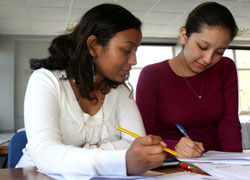Investigate and Experiment

When conducting experiments, remember, “PHPRC” – Purpose, Hypothesis, Procedure, Results, Conclusion.
Investigate: Start with a “problem” you might be interested in…like, do temperature and containment play a part in energy conservation?
Purpose: The purpose is a statement of what you’re trying to figure out: To find out if what parts temperature and containment play in energy conservation.
Hypothesis: A hypothesis is a statement of something you think is true.
Procedure: Here’s where you gather materials or information to do your research and to do your experiment.
For the temperature and containment experiment you’ll need
• 2′ by 3′ cardboard box, one that can be closed
• 100 watt bulb in ceramic socket with electric cord
• thermometer
• box-cutter or knife
• watch, pencil, tape
• plastic food wrap
• stick or ruler
1. Make a way to measure drafts by taping a piece of plastic wrap to a ruler or stick.
2. Cut a small hole in the top of the box for the thermometer – it only needs to be big enough to stick the thermometer through the hole into the closed box.
3. Set the bulb and socket in the box at the end away from the thermometer. Cut a small slit to push the plug and cord through.
4. On one side of the box, cut one small flap near the top and another near the bottom. Cut only three sides of the flap. Make each flap about the size of your palm.
5. Draw a simple chart and record the temperatures at one-minute intervals up to five minutes, setting these different conditions (this is known as “manipulating variables”):
• Temperature in the box with both flaps closed;
• Temperature with both flaps open;
• Temperature with top flap closed, bottom open;
• Temperature with top flap open, bottom closed;
6. Use the plastic wrap taped to a stick to help you record fluctuations in any air flow from your flaps.
Results: List the results of your experiment. Use charts, graphs, or pictures.
Conclusion: What did you learn? Even if you didn’t prove your hypothesis was true, you’ve learned something.



